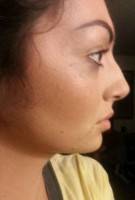Nose hump reduction
Correction of hump on nose
Reducing a small or large dorsal hump is one of the most common reasons for seeking rhinoplasty surgery. With a very small dorsal hump, sometimes all that is required is filing down the vertical height of the nasal bones.
With a larger hump, often once the nasal bones are filed down, this will create an “open roof” deformity where the dorsal of the nose looks flat.
In this case, cuts in the lateral/outside aspect of the bones is required so that they can be collapsed down to eliminate this “open roof” deformity.
The filing down of the bones and the subsequent adjustments to any “open roof” deformity may easily be accomplished through a “closed” surgery approach. (Michael R. Macdonald, MD, Bay Area Facial Plastic Surgeon)
It sounds like you are very clear about your surgical goals and how you would like your nose to look. As the other physicians have mentioned, there are some important considerations for your nose: the structure of the hump itself (bone vs cartilage) and maintenance of the overall balance and harmony of your nose.
I would advise you to be sure and discuss these with your surgeon before you make your decisions. A small hump can generally be approached via the endonasal (closed) approach without the need for breaking the nose. (Travis L. Shaw, MD, Richmond Facial Plastic Surgeon)
Filing down small dorsal hump of nose in rhinoplasty
The “dorsal hump” is mostly cartilage, and is less amenable to rasping or filing down than sharp resection. The osseous (bony) portion will likely need incremental reduction by filing. You and your surgeon need to be ready for more surgery however, depending on the result after filing and resecting the dorsum and rounding it off. If there is an “open roof,” spreader grafts and/or osteotomies may be necessary. In rhinoplasty, when you change one area, you must change others to maintain proportion. Slightly lowering the bump may make your tip appear relatively larger, and thus require tip modification also for a balanced, natural, beautiful result. Just millimeters of change in the nose sometimes requires a good deal of surgical manipulation and technical wizardry. More than meets the layperson’s eye. (Steve Laverson, MD, San Diego Plastic Surgeon)
Dorsal Hump Correction
Based on your description of this minor dorsal hump, it certainly seems amenable to closed rhinoplasty with filing/rasping. Larger dorsal humps tend to involve both bone and cartilage and additional steps to be certain that an “open sky deformity” is corrected by cutting the nasal bones and repositioning them to close this deformity.
Imagine cutting off the top of an A-frame house; that is exactly what an “open sky deformity” is. The vertical beam of the house is the nasal septum; the angled beams are the nasal bones and upper lateral cartilages of the nose. These structures must be carefully assessed when anything larger than a small dorsal hump is to be properly treated. (Jeffrey Weinzweig, MD, Chicago Plastic Surgeon)
Dorsal Hump Removal Rarely Possible without Bone Cuts
Your nose is a shell. In other words, it is hollow. It is not like a solid block of wood that can simply be sanded down into a smaller shape. The thickness of the “shell” is only a couple of millimeters. If your hump is very very small, it may be possible to shave that down without violating the shell. If your hump is that small, you probably don’t need a rhinoplasty. When a hump is taken off of the dorsum of the nose, it leaves what is called an “open roof”. What you have are the two side walls of the nose, a middle wall, but no “roof”. To close the roof, cuts are made on the side walls where they meet your face so that, like an A-frame building, they can be folded in to close the open roof. This is probably the most common and basic of rhinoplasty maneuvers. If this is your only problem, no other part of your nose need be changed, but this is very specific to each person. This type of rhinoplasty is easily done through a “closed” approach, meaning that all incisions are on the inside of your nose. (Louis W. Apostolakis, MD, Austin Facial Plastic Surgeon)
Filing a Dorsal Hump
Every hump is different and so the technique which is best suited for your hump must be individualized. Some humps are bone only whereas others are cartilage only or a combination of cartilage and bone. (Anil R. Shah, MD, Chicago Facial Plastic Surgeon)


